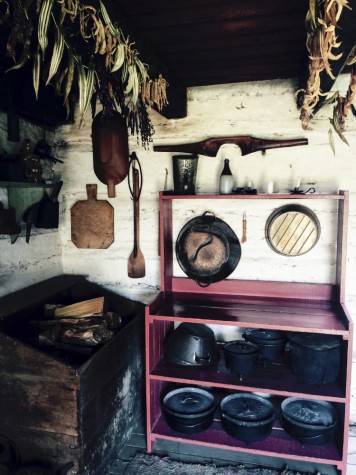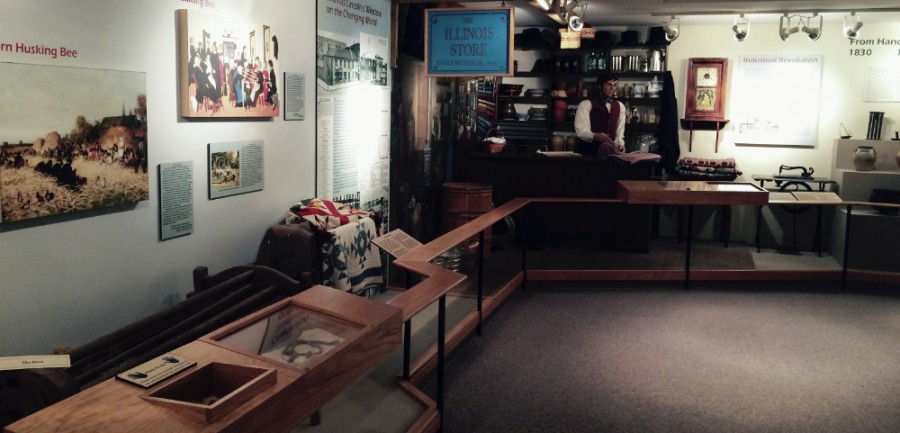Lincoln Log Cabin continues historic values, traditions
A small museum containing historical information on President Abraham Lincoln and life in the 1800s in the Lincoln Log Cabin in Lerna, Ill.
April 26, 2015
Located eight miles south of Charleston in the small village of Lerna is the State Historic Site of Thomas and Sarah Lincoln’s Log cabin—the home of President Abraham Lincoln’s parents.
The 86-acre log cabin, which sits on 402 South Highway Rd., is on the outskirts of Lerna, a village of 283, according to the 2013 City-Data.
Upon visiting the cabin site, visitors are welcomed with the view of a park-like area with large open spaces, makeshift wooden fences housing sheep and lambs, as well as a walkthrough barn, which was built in the 1800s.
When visitors walk through the barn past the human-friendly sheep, they are meet with the view of the old log cabin, which was reconstructed and restored to its original 1800s look in 1936 by the Civilian Conservation Corps.
Matthew Mittelstaedt, the site manager of the log cabin, walked me around the site telling me stories of Lincoln in his younger years as well as the history of the cabin.
“While Abraham Lincoln didn’t live here on the farm, he was a regular visitor especially during the 1840s when he was traveling on the judicial circuit,” Mittelstaedt said.

The kitchen of Thomas and Sarah Bush Lincoln is replicated in the Lincoln Log Cabin in Lerna, Ill.
Mittelstaedt said the cabin was built in two parts, which was evident when I walked through one of the rooms, it was small and housed two old beds, one slid under the larger, an old dresser, farming tools hung on the walls, a weaving machine and a fire pit.
As he lead me through the small room to the other half of the home I had to duck down going through the adjoined middle section of the home, which was divided by a single large fire place. Mittelstaedt explained where the fireplace is where the home was connected as we stepped through into the kitchen; it had an obvious smell of burnt ash and soot from a recently used fire pit. The single fireplace is large enough to have two pits, can heat up the whole house and is used for multiple functions.
“Really, it’s two complete separate cabins,” He said.
The kitchen had dried peppers and ochre hanging from its rafters with cast iron pots and pans situated on the walls or in cabinets. Mittelstaedt said one room would be used for many functions so not only was the kitchen the eating area, but a place for the family to enjoy each other’s company.
He said when Lincoln’s father, Thomas, died he purchased 40 of the 120-acre land the other 80 was given back to his step-brother, John Hall.
Mittelstaedt said Hall wanted to move out to the Ozarks instead of owning and taking care of the farm, which caused the two brothers to have some conflict.
Like any family, the Lincoln’s were no stranger to their family drama as he received several letters from home about who got the money to take care of his step-mother, which some family members claimed to some doing more or less of the caretaking.
“Here, he’s trying to hold the nation together and he’s having to mediate family issues too,” Mittelstaedt said.
While Hall owned the farm, he increased the value of the farm by $1,900, as well as the value of the livestock, and animals slaughtered increasing the total value of the farm to $4,020.
Mittlestaedt said the site sees most of their visitors in the summer for their living history project, which is when people interact with those who dress up similar to during the 1800s and portray individuals how they were.
“They are stepping back in time and they will tell stories about Abraham Lincoln as a boy, but then also his law practice out here,” Mittelstaedt said.
Last year, the log cabin saw about 85,000 visitors and it’s one of the top 10 historic sites in the state. Like many other state historic sites, visitors can come and go at no charge, all that is asked for is a donation upon free-will, which is unique to Illinois, said Mittelstaedt.
Illinois has about 56 state historic sites with nearly 20 of them located in the central region of the state, according to the Illinois Historic Preservation Agency.
Charleston is also home to the Douglas Lincoln Debate museum located on 126 E. Street. The museum features a display of how Lincoln measured up: ‘6 4” in height, size 14 shoe, fist diameter of 11 inches his infamous hat size of 7 1/8; As well as a small diameter of the actual debate in a display case.
In recognition of the 150th anniversary of Lincoln’s assassination, the Log Cabin put on the play “Our American Cousin,” which is what President Lincoln was watching moments before his death.
Roberto Hodge can be reached at 581-2812 or [email protected]
















































